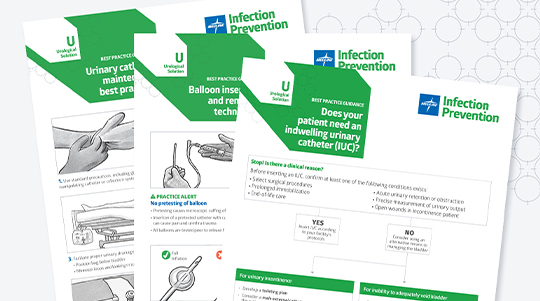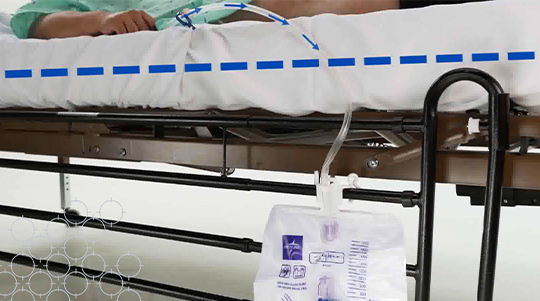Unit champion leads can help you improve CAUTI statistics
Learn how to prevent CAUTI as a group, including frontline staff input.

Most frontline staff know the best practices for preventing catheter-associated urinary tract infections (CAUTIs). But it’s not always easy to put theory into practice.
Here’s the problem: Many clinicians are practicing with limited access to resources, different skill levels and ingrained clinical habits that can keep them from following best practices consistently—especially during a pandemic or other type of emergency. On a hectic, understaffed hospital unit with many patients, they can struggle to do everything that’s critical to keeping patients safe.
The results are discouraging: CAUTIs continue to be one of most common healthcare-associated infections (HAIs), equaling more than 9.5% of infections reported by US hospitals.1 The infection causes patient discomfort, longer lengths of stay, increased mortality, higher costs and lower hospital reimbursement. In fact, more than 13,000 deaths are associated with CAUTI each year.1
But there are ways to change these numbers. One key to better outcomes is to engage unit-based clinical champions and give them the resources to lead prevention efforts across hospital units.
13,000
patient deaths are caused by CAUTIs every year1
“Bedside nurses are tasked with managing indwelling urinary catheters,” says Donna Matocha, DNP, MSN, VA-BC, Medline Clinical Resource Manager – Acute Care. “Look to them for insights on how CAUTI affects the patient experience, as well as what they see as the obstacles to consistently following best practices.”
How frontline champions can help lead CAUTI prevention
“When you provide clinicians with the opportunity to make changes and be heard within their units and their hospital, you can be more successful at reducing CAUTI rates,” explains Matocha.
It’s all about building a prevention team that includes the right champions: clinicians that care deeply about driving a culture of safety and inspiring frontline staff to always follow best practices for CAUTI prevention; reducing the use and duration of indwelling urinary catheters (IUCs); minimizing their duration of use; and following aseptic technique.
“You need a champion in every unit who’s going to focus on keeping everyone on task.”

Donna Matocha, DNP, MSN, VA-BC
Medline Clinical Resource Manager – Acute Care
And evidence shows that this model works. When the Comprehensive Unit-based Safety Program (CUSP) from the Agency for Healthcare Research and Quality (AHRQ) was applied to more than 900 hospital units, CAUTI rates decreased an average of 16%.2
So how do you build a unit-based champion team?
Our Urological Solution for CAUTI prevention includes a CAUTI-Prevention Champion Team Playbook that guides you on how to select the right champions for your prevention team.
Champions should be frontline clinicians who know CAUTI prevention best practices. They should be strong leaders and communicators, and show a passion for mentoring others. A typical champion team includes the following roles:
- CAUTI Champion Lead oversees your prevention team by coordinating and documenting all activities and meetings, and encouraging team communication and feedback. This individual should have deep knowledge of CAUTI prevention best practices and the time to dedicate to the project lead role.
- Senior Executive helps set your safety goals, get you the resources you need and makes sure your prevention efforts are a priority at the hospital. Senior leaders should meet with the team and frontline staff regularly and communicate the team’s mission and goals to other stakeholders in the organization.
- CAUTI Coach encourages teamwork and communication on the unit, engaging and guiding bedside staff in CAUTI prevention. CAUTI coaches should have clinical expertise in IUC care practices and working knowledge of IUC-related policies and procedures.
- CAUTI Manager works with other team members to help your frontline staff participate in prevention efforts and understand the right policies and procedures. This includes developing staff education like train-the-trainer presentations, bulletin boards, activities and other learning tools.
- Infection Preventionist/CAUTI-Improvement Advisor helps the team design strategies to improve current prevention practices by studying data on IUC use and identifying the root cause of infection events. This can begin with a discovery assessment to find any existing gaps in practice that could be leading to CAUTI.
Key takeaway
CAUTIs continue to be one of most common HAIs. Lowering CAUTI rates depends on getting champions involved to support a culture of prevention—from the executive suite to bedside clinicians.
“Buy-in from senior leadership helps promote initiatives as a patient safety priority and aids in system-wide change,” says Matocha. “At the same time, you’ve got to involve the bedside nurses and empower them with the training and resources they need to help drive consistent best practices on every unit.”
References:
- Urinary Tract Infection (Catheter-Associated Urinary Tract Infection (CAUTI) and Non-Catheter-Associated Urinary Tract Infection (UTI) and Other Urinary System Infection (USI) Events. Centers for Disease Control and Prevention website. Available at: http://www.cdc.gov/nhsn/PDFs/pscManual/7pscCAUTIcurrent.pdf
- Association for Professionals in Infection Control and Epidemiology. On the CUSP: Stop CAUTI Supplement—Spring 2014. Available at: https://musite.s3.amazonaws.com/Urological+Solution/APIC-On-CUSP-Stop-CAUTI-Supplement+(1).pdf




